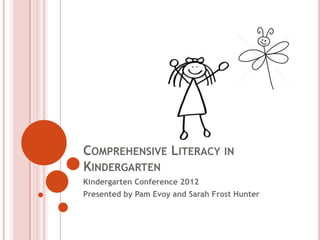
Comprehensive literacy in k[1][1][1]
- 1. COMPREHENSIVE LITERACY IN KINDERGARTEN Kindergarten Conference 2012 Presented by Pam Evoy and Sarah Frost Hunter
- 2. GOALS FOR TODAY: To be able to clearly articulate the literacy goal(s) for our Kindergarten students To explore the elements of a comprehensive literacy program To share ideas and co-plan
- 3. KEEPING OUR LEARNERS IN MIND
- 4. CURRENT VIEW OF LITERACY DEVELOPMENT “Emergent Literacy” is based on the idea that children learn literacy as they come to it rather than as it comes to them … Children’s engagement with books, reading, and writing is more holistic and well- rounded as reading and writing activities are based upon children’s natural curiosity and discovery and integrated into a classroom’s overall curriculum and content. Thinking it Through. “Literacy and the Young Child”.p/5
- 5. OUR MAIN GO-TO SOURCE Although children develop skills in reading, writing, and oral language ( listening and speaking) , oral language must be the foundation of literacy development in the Full-Day early Learning-Kindergarten programme.
- 6. Evolving View: Four Roles of the Literate Learner Adapted from page 9 of Literacy for Learning: The Report of the Expert Panel on Literacy in Grades 4 to 6 in Ontario (2004). Based on Freebody and Luke’s “Four Resources Model” (1990). The Expert Panel elaborated on the four resources model to suggest four roles of a developing junior learner. The Evolving View: Four Roles of the Literate Learner is for discussion purposes only and is based on the work of the Collaborative Inquiry in Literacy 2008–09 and 2009–10. 6
- 7. COMPREHENSIVE LITERACY: SO WHAT DOES IT CONSIST OF?
- 8. ZEROING IN ON ONE COMPONENT – REPEATED INTERACTIVE READ ALOUD First Second Third Book Intro Teacher Characters/info Identify summarized. reminders. General problem/solution Outward (ie.cover/ questions asked re: or build upon title) visuals characters, or connections to highlighted connections to things facts and already known. extensions to other things. Book Reading Insert vocab for 5-10 Insert vocab Predictions based words already pre- enhancements for on two page selected. same 5-10 words. spreads and extensions, including vocab in different contexts After Reading Why question Ask another “WHY” Discussion requiring explanation. Demonstrate how to answer by “I’m thinking
- 9. ALLOWING CHILDREN TO COME TO LITERACY What might a classroom context look like to incorporate all these theoretical elements?
- 11. HOW DOES THE CURIOSITY ALLOW THE PROGRAMME TO BE UNCOVERED?
- 12. A PURPOSEFUL(RESEARCH-BASED) APPROACH TO READ ALOUD Repeated Readings Focused and short Interactive rather than passive Reading Teacher Student 1 2 3
- 13. Tracking Learning to Keep Moving Forward
- 14. YOUR TURN Select from the materials Range of Planners provided Plan how you would use the Repeated Interactive Read Aloud method to expand into other components of comprehensive literacy
- 15. VOICES FROM THE FIELD
- 16. THANK YOU AND MAY YOU CONTINUE TO LEARN WHILE YOU TEACH AND TEACH WHILE YOU LEARN EXIT PASS
Notas do Editor
- How is literacy built in your classroom? Who/what comes first? The programme or the child?
- This is the spirit of the programme …. A child/teacher initiated continuum of learning in all areasKindergarten, unlike any other grade perhaps, must position oral language at the core of literacy. We need to keep this in mind when we think of reading and writing.
- While the LukeFreebody research is a framework that overarches what we do, at the classroom level, we have what is known as comprehensive literacy … a way of incorporating elements of support to develop our learners towards independence.
- Summary of steps taken to repeat an interactive read-aloud. Research based. Highlighted in Ministry video entitled Kindergarten Matters: Planned, Purposeful and Playful Talk
- Transition from theory to practice. At your tables you have things that MIGHT have been used as a way of provoking inquiry (if something had not bubbled up already from children’s play). Take a moment to investigate what is on your table.
- Starting with a provocation or a child interest and building upon that … use example This could be the start of an inquiryUse Sarah’s example for our pretend Inquiry
- So, it is not good enough to simply start wondering about ‘snails’ . We need to know how such an inquiry may lend itself to letting us uncover the programme expectations and promote learning. We think about how we might extend and focus learning through opportunities in the 6 areas of learning ie. Personal/social, Language, Math, Sci/Tech, Health/PhysEd and the Arts. Each and every area lends itself to literacy development by ensuring that language opportunities are embedded in authentic ways. While given opportunities to observe snails in a terrarium environment, children may be encouraged to use journal entries, as they had seen during an interactive read aloud, to record observations about estimates of distance of movement in an amount of time, or mimicking snail movement and how a whole body moves etc. etc. Vocabulary, scientific note taking, opportunities for rhyming etc all flow from a natural curiosity as opposed to one that is announced by teacher.
- With the document in mind, we can now see how a repeated interactive read-aloud may help us uncover the curriculum in some ways.Sarah demonstrates.
- Ways to track …. Paper pencil and also mention Noteshelf.
- Serge’s Spring Inquiry
